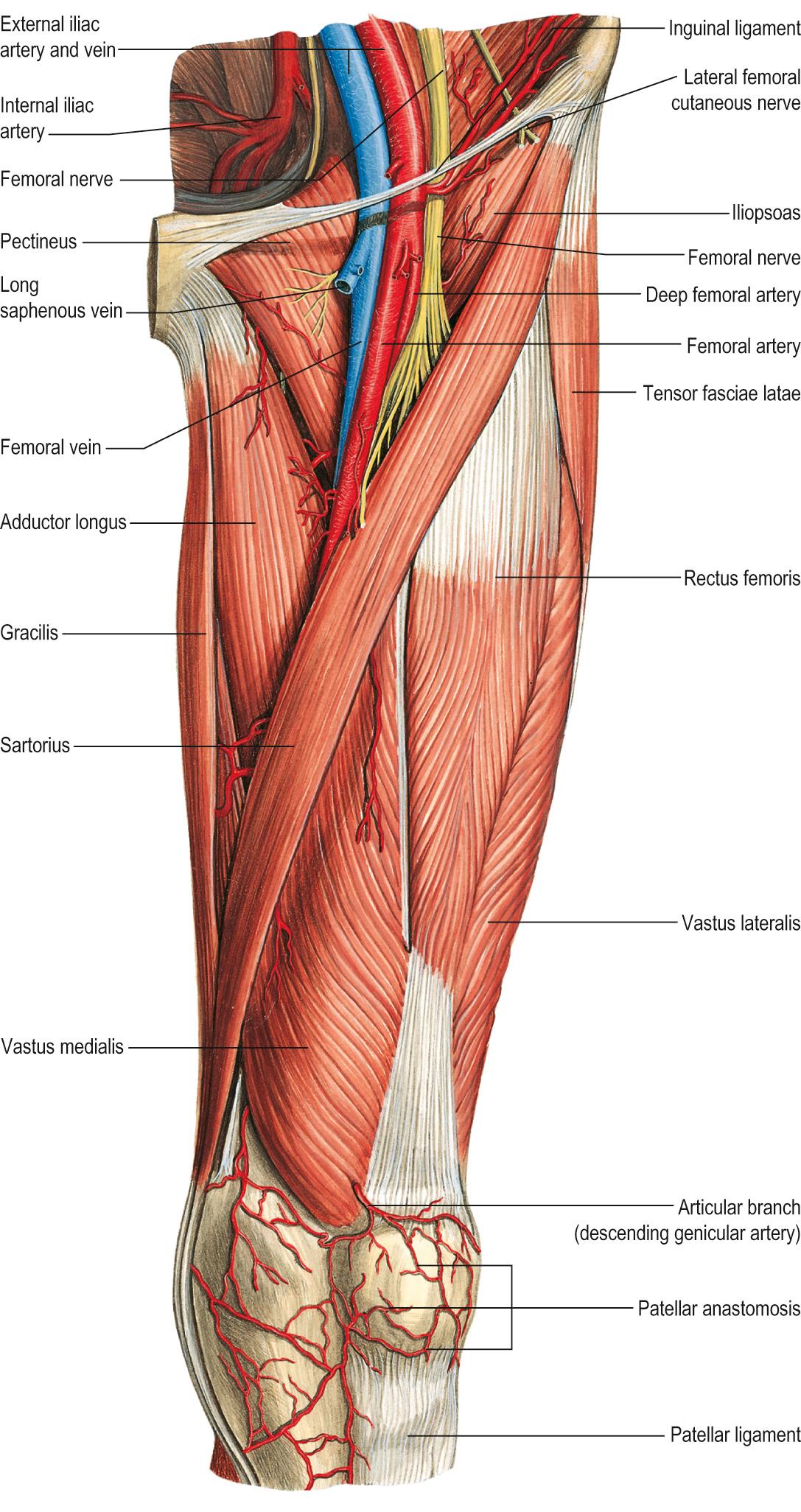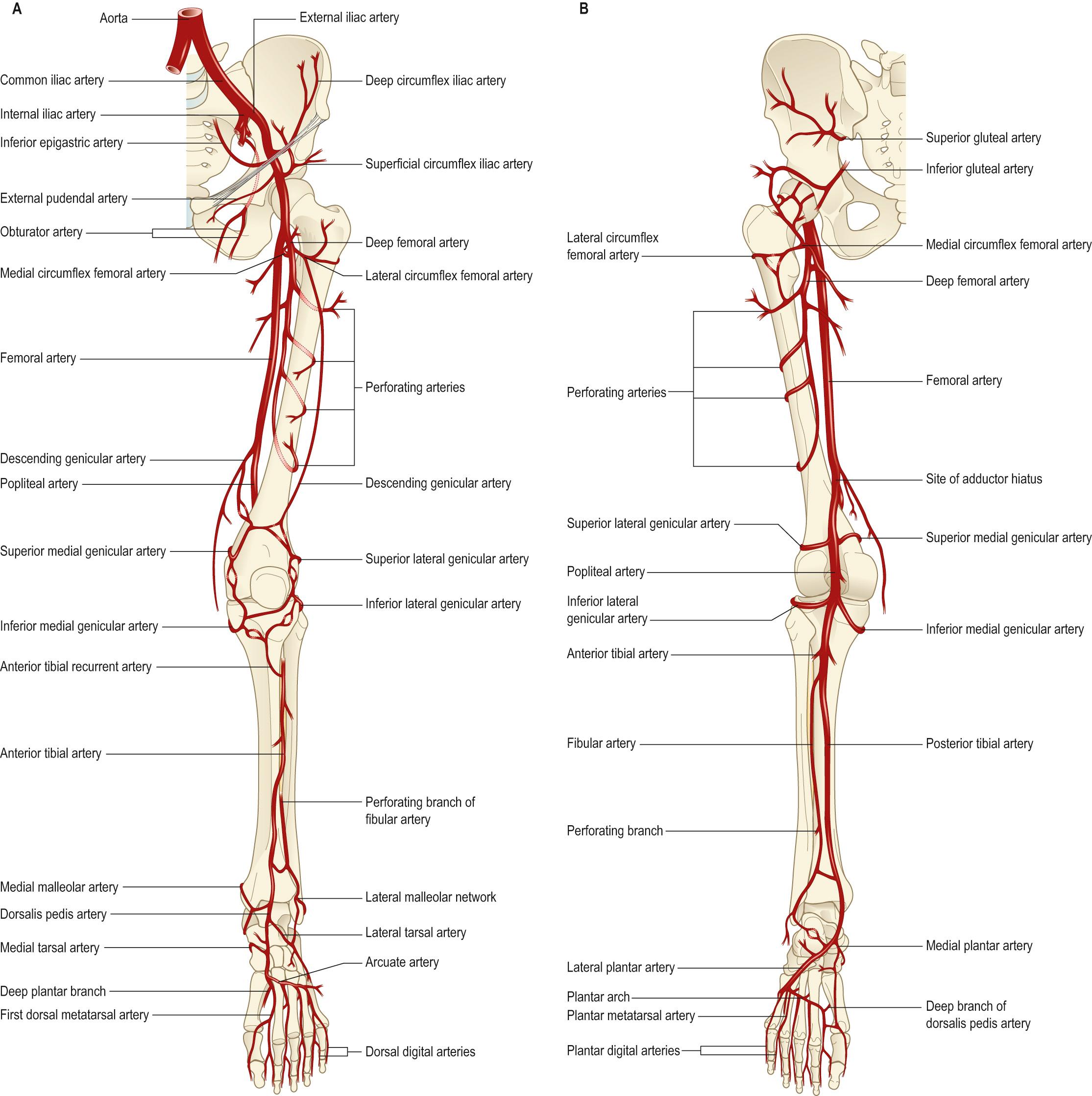Physical Address
304 North Cardinal St.
Dorchester Center, MA 02124
Access to the distal aorta and iliac vessels
Exposure of the femoral vessels
Access to the proximal popliteal artery
Access to the distal popliteal artery
Approach to the anterior tibial artery
Access to the posterior tibial artery
Access to the fibular artery
Long saphenous vein harvest
Lower limb four-compartment fasciotomies
Varicose vein surgery
The common iliac arteries develop from the union of the umbilical arteries and fifth lumbar dorsal intersegmental arteries during early gestation. The internal iliac arteries are derived from the fifth lumbar ventral segmental artery. The blood supply to the lower limb is initially via the sciatic artery, which forms as a branch of the umbilical artery. A second system develops in the lower limb at 6 weeks’ gestation, when the common iliac artery gives rise to the external iliac artery. The sciatic artery almost completely regresses, although portions persist to form the popliteal and fibular arteries, and the inferior and superior gluteal arteries.
The femoral artery is located roughly along an imaginary line drawn from the mid-inguinal region to the adductor tubercle and within the femoral triangle proximally ( ![]() ). The femoral triangle (Scarpa's triangle) is located between sartorius, the medial border of adductor longus and the inguinal ligament ( Fig. 77.1 ). The floor of the triangle is composed of iliopsoas and pectineus, and the fascia lata forms its roof. From lateral to medial, the triangle contains the femoral nerve, femoral artery, femoral vein and femoral canal; the femoral sheath surrounds the artery, vein and canal but not the nerve. The femoral canal contains lymphatics and a lymph node (of Cloquet); it can allow the passage of abdominal contents as a femoral hernia, which is visible inferolateral to the pubic tubercle.
). The femoral triangle (Scarpa's triangle) is located between sartorius, the medial border of adductor longus and the inguinal ligament ( Fig. 77.1 ). The floor of the triangle is composed of iliopsoas and pectineus, and the fascia lata forms its roof. From lateral to medial, the triangle contains the femoral nerve, femoral artery, femoral vein and femoral canal; the femoral sheath surrounds the artery, vein and canal but not the nerve. The femoral canal contains lymphatics and a lymph node (of Cloquet); it can allow the passage of abdominal contents as a femoral hernia, which is visible inferolateral to the pubic tubercle.

The subsartorial (Hunter's) canal extends from the apex of the femoral triangle to the adductor hiatus. It is bordered by sartorius anteriorly, vastus medialis laterally and adductors longus and magnus posteriorly, and contains the femoral artery and vein, the saphenous nerve and the nerve to vastus medialis. The femoral artery becomes the popliteal artery as it exits the canal. The popliteal artery is located initially along an imaginary line drawn from the lateral margin of semimembranosus obliquely downward to the centre of the popliteal fossa, and then along a line drawn through the lower part of the tibial tuberosity, running vertically for 2.5 cm.
The anterior tibial artery arises about 3 cm inferior to the head of the fibula and runs along an imaginary line from the medial side of the head of the fibula to midway between the malleoli, where it becomes superficial at the ankle and palpable as the dorsalis pedis pulse between the tendons of extensor digitorum longus and extensor hallucis longus. The posterior tibial artery travels along a line from the termination of the popliteal artery to the medial malleolus, where it becomes superficial at the ankle and palpable posterior to the medial malleolus. The fibular artery (peroneal artery) arises 7–8 cm inferior to the knee and follows the line of the fibula distally to its lateral malleolus.
The saphenous opening is a defect in the fascia lata inferior to the medial part of the inguinal ligament and inferolateral to the pubic tubercle. The opening is occupied by cribriform fascia (Hesselbach's fascia). The long saphenous vein and lymphatics from the superficial lymph nodes pass through the saphenous opening and cribriform fascia to enter the femoral vein and the deep inguinal nodes, respectively.
The long saphenous vein arises at the dorsum of foot, passes 2 cm anterior to the medial malleolus (it can be approached for a long saphenous vein cut-down at this point), ascends the medial leg, passes immediately posterior to the medial femoral condyle (a hand's breadth posterior to the patella), then passes up the medial thigh to drain into the femoral vein. The junction of the long saphenous vein with the femoral vein typically lies 2.5–4.0 cm inferolateral to the pubic tubercle, but can be closer to the pubic tubercle in women.
The short saphenous vein passes posterior to the lateral malleolus and ascends the posterior aspect of the calf to enter the popliteal vein behind the knee.
The aorta bifurcates at the L4 vertebral level into the common iliac arteries, which cross the linea terminalis, lying inferolaterally along the medial border of psoas major, and divide into the external and internal iliac arteries at the linea terminalis anterior to the sacro-iliac joint. The right common iliac artery can compress the left common iliac vein against the lumbar spine as the vein crosses from left to right to enter the inferior vena cava. This can cause left lower limb swelling and deep vein thrombosis (May–Thurner syndrome), which is more common in females than males and tends to present in the second to fourth decades of life. May–Thurner syndrome rarely involves the right common iliac vein.
The internal iliac arteries predominantly supply the structures of the pelvis and muscles of the thigh and gluteal region, whereas the external iliac arteries are the main suppliers of blood to the lower limb ( Fig. 77.2 ).

The exact configuration of the internal iliac artery is variable but it usually divides into anterior and posterior divisions.
Become a Clinical Tree membership for Full access and enjoy Unlimited articles
If you are a member. Log in here